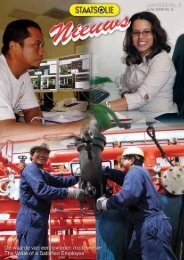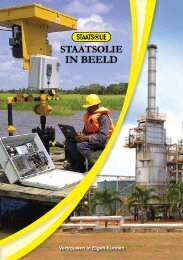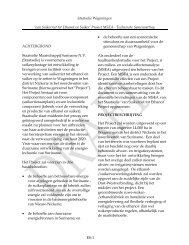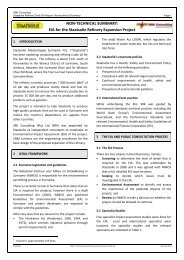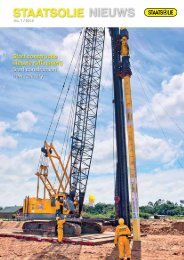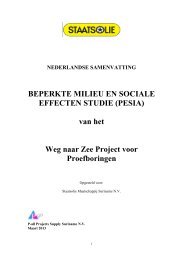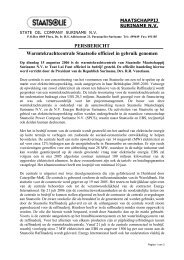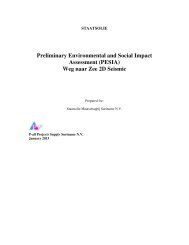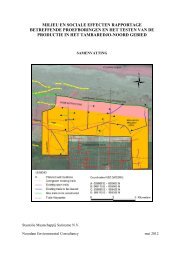concept EIA-rapport - Staatsolie
concept EIA-rapport - Staatsolie
concept EIA-rapport - Staatsolie
You also want an ePaper? Increase the reach of your titles
YUMPU automatically turns print PDFs into web optimized ePapers that Google loves.
SRK Consulting: Project No: 439414 <strong>Staatsolie</strong> Pipeline <strong>EIA</strong> – Draft <strong>EIA</strong> Report Page 71<br />
Probability of an incident<br />
Generally, the main causes of pipeline failures, though rare, are:<br />
• Damage from anchors, vessels or dropped objects (offshore pipelines);<br />
• Third party interference (e.g. digging or driving stakes into the ground) (terrestrial pipelines);<br />
• Material defect;<br />
• Mechanical failure (e.g. excess pressure in the pipeline, splitting weld or stress on the steel);<br />
• Natural hazards (e.g. flooding, landslides, earthquakes and sinkholes); and<br />
• Operator error or malfunction of the pressure control and protection systems.<br />
The risk of a pipeline incident is generally highest for the land-based portions of the pipelines and the<br />
areas where the underground pipeline lies shallowest near the drill entry and exit points, as these<br />
sections are more exposed. The risk of a pipeline failure through third party interference / external<br />
damage decreases rapidly with the increasing depth of the pipeline underground. Natural hazards<br />
are considered a relatively unlikely risk in Suriname, as the geology is considered very stable. Risk<br />
stemming from operator error or malfunction can be minimised through the use of backup systems.<br />
Impact if the incident occurs<br />
The accidental release of large volumes of fuel from the pipeline could have a number of potential<br />
impacts:<br />
• Pollution of groundwater;<br />
• Pollution of the Suriname River and terrestrial areas;<br />
• Health hazard to people exposed to the leaked fuel; and<br />
• Fire due to the ignition of the fuel.<br />
Pollution of groundwater<br />
As indicated in the section above, the soil profile along the pipeline corridor appears to consist<br />
predominantly of clay, with intermittent silt and sand content, found most commonly at depth of 20 to<br />
30 m. The water contained in these sand bodies exhibits a negative hydraulic pressure 36 , which<br />
appears to illustrate both the embedded character of the sand body and the impermeability of the<br />
surrounding clay. The pipeline may cross some of these sand bodies, in which case the negative<br />
pressure is likely to be neutralized by allowing the inflow of additional groundwater. Should a pipeline<br />
leak in this or a nearby section, any leaked hydrocarbons will enter the sand body, but are unlikely to<br />
move far from the leak due to the absence of groundwater flow. The spread of pollutants is only<br />
possible through diffusion, which is a very slow process, and the contamination will remain localized.<br />
In places where the pipelines lie within or very close to the Zanderij aquifer, a leak would cause only<br />
localised contamination of the aquifer, because groundwater flow is virtually absent (as there is no<br />
extraction) and diffusion is slow, coupled with a tendency for the hydrocarbons to move upwards.<br />
The water in the Zanderij aquifer is brackish in the study area and not used for drinking water.<br />
Contamination of deeper-lying aquifers that do provide drinking water is not considered plausible<br />
because of the thickness of the Zanderij aquifer and the presence of a clay layer between aquifers 37 .<br />
36 The water pressure is lower than in the surrounding environment and so has a tendency to remain in situ rather than flow.<br />
37 Some diffusion from the Zanderij to the Coesewijne aquifer is shown by Groen, but this is a very slow process.<br />
REUT/DALC 439414_<strong>Staatsolie</strong>Pipeline<strong>EIA</strong>_Draft <strong>EIA</strong> Report_Final June 2012




